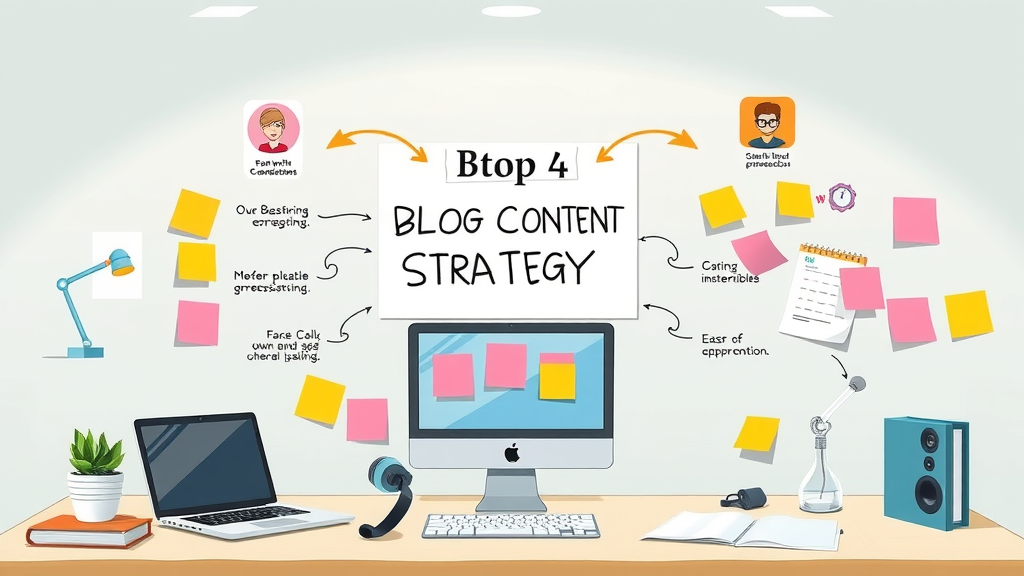Did you know that companies with a consistent blog content strategy are 13 times more likely to see positive ROI? The digital marketing landscape is flooded with fleeting trends, but the secret to long-term, scalable success lies in a well-crafted content plan that goes far beyond simply publishing blog posts. In this comprehensive guide, you’ll uncover the not-so-obvious factors that top brands leverage to dominate organic traffic, drive more leads, and build authority in their niche. Ready to discover the proven blueprint for blogging success?
Revealing the Statistics: Why a Blog Content Strategy Sets Top Brands Apart
When it comes to online visibility and brand growth, blog content strategy is the true differentiator. Research consistently shows that brands with a documented content strategy enjoy 60% higher content effectiveness and build greater trust with their target audience. For instance, businesses that update their blogs regularly with well-planned, keyword-driven content see up to 97% more inbound links than those who publish sporadically. This structured approach lets marketing teams plan blog posts, optimize for search engines, and engage potential customers at every stage of the buyer journey.
Imagine a content marketer at a leading tech company. Instead of randomly publishing topics, they follow a systematic editorial calendar aligned with both short-term marketing campaigns and long-term brand-building goals. The result? Their organic reach grows steadily, and their blog becomes a trusted resource, consistently driving traffic and generating leads. This is why a robust blog content strategy doesn’t just set successful businesses apart—it virtually guarantees their momentum.

- How to craft a winning blog content strategy from scratch
- The essential components behind effective blog content
- How content marketing and a marketing strategy integrate with blogging success
- Actionable tactics to reach and grow your target audience
- Proven ways to build an editorial calendar for consistent results
- Expert tips for amplifying your blog post reach and engagement
Defining Blog Content Strategy: Building Blocks for Blog Content Success
Establishing a strong blog content strategy requires an understanding of its core elements. Think of it as the foundation upon which every successful blogging strategy stands. At its heart, this strategy combines elements like keyword research, content planning, editorial scheduling, and careful alignment with your broader content marketing objectives. For any organization, from startups to established brands, having these building blocks in place is essential to publishing relevant, high-quality blog content that resonates with the target audience and helps achieve measurable business goals.
A well-executed content strategy also means avoiding common pitfalls, such as neglecting keyword research or failing to maintain an editorial calendar. It entails intentional topics selection, using data-backed insights from content audits and performance analytics, to consistently meet the needs of potential customers. With these critical elements in place, your brand's blog can evolve from a mere collection of articles to a dynamic engine that drives organic traffic and strengthens brand authority across every digital touchpoint.
| Element | Description |
|---|---|
| Blog Content Strategy | A comprehensive plan for blog content creation |
| Content Marketing | Promoting valuable blog content |
| Editorial Calendar | Scheduling blog posts for consistency |
| Keyword Research | Identifying topics for maximum reach |
What is a Blog Content Strategy? [People Also Ask]

A blog content strategy is a structured framework designed to guide the creation, delivery, and management of your blog content to achieve broader marketing goals. It ensures every blog post aligns with your brand’s objectives and the needs of your target audience. In practice, this means deciding what to write about, how to optimize content for search engines, when to publish, and how to measure performance—all while maintaining a unique, value-driven voice that distinguishes your brand in a crowded digital landscape. Effective strategies not only help you create content, but ensure the results are both meaningful and measurable for your business.
Laying the Foundation: Developing an Effective Blog Content Strategy
Building an effective blog content strategy begins long before your first draft. First, you must understand your target audience at a granular level, using buyer personas that capture their pain points, preferences, and goals. Successful brands also perform a thorough content audit to assess existing assets—identifying what performs, what’s outdated, and where there are gaps in your blog content. This sets the stage for smart keyword research, which uncovers questions, topics, and formats that can drive sustained engagement from both search engines and readers.
Setting SMART goals for your blogging strategy keeps your efforts focused and actionable. These goals might include increasing organic traffic by a certain percentage, growing lead generation through specific blog posts, or building thought leadership in key industry topics. Ultimately, the best strategies are iterative, evolving according to performance data and changing audience needs. This foundational work forms the roadmap for producing quality content that establishes enduring authority and keeps your brand top-of-mind.
Understanding Your Target Audience: Building Accurate Buyer Personas

Knowing your target audience is crucial. To create compelling blog content, start by designing detailed buyer personas —fictional representations based on actual data about your ideal readers. These personas should include demographic details, behavioral patterns, values, goals, and specific challenges your potential customers face. By understanding your audience’s search intent, content preferences, and pain points, you can consistently deliver relevant content that builds trust, loyalty, and engagement over time.
Collaborate with your sales team or customer service representatives to gather real-world insights into customer interactions. Surveys, interviews, and social listening tools are also invaluable for identifying trends and emerging needs within your audience segments. The more accurately you define your buyer persona, the more likely your blog content will successfully solve readers’ problems and motivate action—whether that’s subscribing to your newsletter, sharing a blog post, or moving further down your sales funnel.
Conducting a Comprehensive Content Audit for Blog Content Improvement
A content audit helps you maximize your blog’s potential. Start by cataloging every blog post you’ve published, then assess each one for relevance, up-to-date information, and keyword optimization. Look for gaps—topics your target audience cares about but aren’t addressed in your current content. Use analytics to highlight which posts drive traffic and which underperform. From there, prioritize updates, consolidations, or removals to ensure your blog always reflects the highest-quality content that supports your marketing strategy.
Tools like Google Analytics and content management system exports make auditing easier. Pay attention to bounce rates, time on page, backlinks, and social shares. The audit process positions you to refresh old blog posts, enhance internal linking, and discover opportunities for new blog content—enabling continuous improvement of your blogging strategy and long-term visibility on search engines.
Mastering Keyword Research for a Blog Content Strategy that Performs
Effective keyword research is the backbone of a high-performing blog content strategy. By identifying and prioritizing the phrases your potential customers use to seek information, you ensure every blog post is optimized for discoverability and relevance. Begin by analyzing top-performing competitor blogs, using keyword tools to spot high-volume, low-competition topics that align with your audience’s needs. Integrate primary and secondary keywords naturally into your headlines, meta descriptions, and body text for maximum impact.
Beyond simple keyword inclusion, consider search intent—are users looking for how-tos, product comparisons, or expert opinions? Build a content calendar that balances evergreen topics (with steady search demand) and trending subjects (to rapidly attract attention). With a robust approach to keyword research, you’ll consistently create content that ranks higher, pulls in organic traffic, and reinforces your brand’s expertise within your niche.
Setting SMART Goals to Guide Your Blog Content Strategy
SMART (Specific, Measurable, Achievable, Relevant, Timely) goals provide essential guardrails for your blog content strategy . These well-defined targets help focus content creation and align blogging efforts with broader marketing and business objectives. For example, you might aim to increase blog traffic by 30% in six months, boost newsletter signups by 20%, or elevate specific posts to the first page of Google for targeted keywords.
Regularly reviewing progress toward SMART goals keeps teams accountable and uncovers what’s working (or not). Adjusting your editorial calendar, exploring new types of content, or revisiting keyword research can all result from tracking these objectives. When your blog content strategy is driven by concrete goals, it becomes easier to prove ROI and make the case for further investment in content marketing initiatives.
Strategizing for Success: Content Marketing, Content Strategy, and Your Blog Content
To build momentum, your blog content strategy should be tightly woven into your overall content marketing strategy . Consistent messaging, cross-channel promotion, and clear brand positioning turn each blog post into a stepping stone within a larger journey—by the time readers encounter your sales team or marketing campaigns, they’ll already trust your credibility and expertise. Consider collaboration between content creators and the marketing team to develop topics that support both immediate campaigns and long-term brand authority.
The integration of blog content into the big picture of marketing strategy makes it easier to repurpose, syndicate, and amplify. For example, a research-backed blog post can be transformed into an email series, a video, or multiple social media posts—multiplying its impact and reach. The more aligned your content, the greater the chances your message sticks with your target audience , building loyalty and competitive advantage.
Integrating Blog Content with Your Overall Content Marketing Strategy
Full integration happens when blog content is not created in isolation. Collaborate with sales, customer support, and other departments to inform topics and ensure your blog answers the real needs of your potential and existing customers. Content calendars that mirror seasonal campaigns, product launches, or industry events keep your blog relevant and highly visible, maximizing every piece of content’s return on investment.
Track how each blog post feeds into larger content campaigns—does it support lead magnets, nurture sequences, or drive social engagement? The more overlap between your blog content strategy and broader content marketing efforts, the stronger and more sustainable your results.
Aligning Blog Content Strategy and Marketing Strategy for Brand Authority
Your marketing strategy and content strategy are interdependent. When blog content directly contributes toward organizational goals—building brand authority, generating quality leads, or positioning you as an industry thought leader—you maximize the return on every content investment. Plan your blog content around pillar topics that are central to your brand’s values and solutions, reinforcing core messaging at every touchpoint.
Leading content marketers recommend regular meetings between all content stakeholders to share wins, lessons learned, and areas in need of improvement. This ensures alignment, maintains focus on high-priority objectives, and enables more agile responses to market shifts or search engine updates.
"A successful blog content strategy is not about writing more, but about delivering meaningful value to a clearly defined audience."
From Planning to Publishing: Core Elements of a Powerful Blog Content Strategy

Every successful blog content strategy moves seamlessly from topic ideation through to publication and promotion. Begin by maintaining a detailed editorial calendar, which outlines when, where, and how your blog posts will go live. This not only guarantees consistent publishing, but makes it easier for your marketing team to plan promotional activities, avoiding gaps and overlaps in your content creation schedule.
Content creation itself hinges on both creativity and adherence to SEO best practices. Write posts that are deeply valuable, unique, and actionable—incorporate strategic keywords, punchy headlines, internal and external links, and strong calls to action. Don’t forget to leverage visuals; infographics, images, and video can transform an ordinary blog post into an engaging resource that’s highly shareable across social media.
Lastly, streamline your workflow by categorizing types of content—such as how-tos, case studies, listicles, expert interviews—so you deliver diverse value throughout the editorial calendar. By consistently monitoring what works, you can double down on successful blog post formats and topics that resonate most with your readers.
Creating an Editorial Calendar for Publishing Blog Posts Consistently
An editorial calendar is a must-have for every content marketer seeking predictable results. List topics in advance, assign deadlines, and align your publishing schedule with broader business milestones. This level of planning makes your blogging strategy proactive rather than reactive, reducing stress, preventing content gaps, and ensuring each post serves your content and marketing goals.
Editorial calendars come in many forms—from simple spreadsheets to advanced project management tools. No matter the format, the key is consistency: set a publishing cadence that matches your resources, and stick to it. Tracking your blog posts in a centralized calendar also enables collaboration between writers, editors, and promotional teams, leading to smoother content production and higher quality content overall.
Content Creation: Crafting Shareable and SEO-Optimized Blog Content

Creating content that stands out requires blending creativity, research, and SEO. Begin with compelling headlines that clearly communicate the benefit to the reader. Structure each blog post for readability—use subheadings, bullet points, and short paragraphs to encourage consumption. Embed relevant keywords naturally, optimize metadata, and supplement with authoritative images or infographics for a richer user experience.
Beyond the basics of SEO optimization, develop content for every stage of the buyer’s journey. Educational posts attract top-of-funnel visitors, while case studies and product comparisons help convert readers to leads or customers. The most effective content creation process includes rigorous editing, clear calls to action, and routine monitoring to ensure that every post provides maximum value to both readers and search engines.
Selection of Types of Content That Elevate Your Blog Content Strategy
Experimenting with a variety of types of content keeps your blog fresh and your audience engaged. Consider mixing evergreen guides, trend analyses, personal stories, curated lists, and industry news updates within your editorial calendar. Different formats appeal to different browsing behaviors, which increases the odds your blog content will resonate and be shared.
Analyze your blog’s performance regularly to spot which formats attract the most organic traffic, comments, or social shares. Use these insights to refine your blogging strategy—doubling down on winning types of content and sunsetting approaches that no longer deliver results. Over time, this iterative process lifts your brand authority and boosts the ROI of your content marketing.
Using a Content Calendar to Streamline Blog Post Scheduling
A robust content calendar does more than track post dates—it provides visibility into your entire content production pipeline. Assign roles, set milestones for topic ideation, drafting, editing, and promotion, and ensure that no step is overlooked. This systematized approach enables both solo bloggers and large teams to maintain high standards in content quality and publishing frequency, essential for scaling blog content in alignment with business goals.
Calendars can also be integrated with alert systems and collaboration tools, ensuring that the right people are notified when it’s their turn to contribute. The more efficiently you schedule and execute your content plan, the more resources you have to experiment, analyze, and iterate on future blog content and strategy.
Social Media and Blog Content: Amplifying Reach in a Competitive Digital World

Strong social media promotion transforms each blog post from a website asset into a shareable, viral opportunity. Consistently promoting blog content on platforms like LinkedIn, X (Twitter), Facebook, and Pinterest expands your reach well beyond inbound organic search. For fast-growing brands, integrating social sharing into your content calendar ensures every new post gets the attention it deserves.
Experiment with different types of content for each channel—snackable tips for X, infographics for Pinterest, and deep-dive articles for LinkedIn. Engage your audience by responding to comments, initiating conversations, and encouraging shares. The result is not only amplified reach, but also the feedback needed to further improve your content and strategize for the next round.
Maximizing Blog Impact with SEO and Analytics
For a blog content strategy to drive real business results, you must pair expert SEO tactics with close analytics monitoring. Search engines reward regularly-updated, well-optimized blogs with higher rankings and steady organic traffic. This means diligent keyword research, on-page SEO, and quality backlinks all play a role in your blogging strategy’s impact.
Analytics turn intuition into certainty. Track traffic sources, top-performing posts, engagement metrics, and conversion rates using tools like Google Analytics or SEMrush. By measuring the ROI of your blog posts and understanding which topics, formats, and distribution channels work best, you can make data-driven decisions to improve your content plan and maximize growth potential.
Driving Growth: How Search Engines Influence Blog Content Strategy

Search engines are the gatekeepers of digital discovery. That’s why modern blog content strategy puts equal weight on both high-quality content and technical optimization. Use structured data, clear title tags, internal linking, and fast-loading images to ensure every blog post is easily crawlable and indexable. Focus on E-E-A-T (Experience, Expertise, Authoritativeness, Trustworthiness), an increasingly important ranking factor for Google.
Regular SEO audits help you spot technical issues and content gaps that might hinder ranking. Pay close attention to your competition and keywords—they’ll guide you toward the topics most likely to drive sustainable blog growth in highly competitive spaces.
Tracking Performance: Measuring the ROI of Blog Posts and Content Marketing
To prove—and improve—the value of your blogging strategy, consistently track performance. Key performance indicators (KPIs) such as organic traffic, page views, average session duration, conversions, and social shares are essential for evaluating content effectiveness. Set up regular analytics reporting to spotlight which posts drive traffic and which fall short so you can refine your editorial roadmap and blog content strategy.
Over time, use these insights to double down on high-converting content, retire underperforming topics, and tweak SEO tactics for even better results. Continuous performance review is the hallmark of a content marketer dedicated to long-term growth and impact.
The 80/20 Rule for Blogging: Focusing on Content that Accelerates Results [People Also Ask]
The 80/20 rule in blog content strategy suggests focusing on the 20% of your topics and efforts that generate 80% of your traffic, engagement, and results. Identify and double down on high-impact blog post ideas.

For most brands, a small fraction of blog posts drive the lion’s share of results. By identifying and prioritizing these topics—often found through a content audit and analytics—you can exponentially increase your ROI. This approach streamlines content creation by focusing resources where they’re proven to be effective, reducing wasted effort and amplifying the impact of your blogging strategy over time.
Analyze historical data to discover which pieces generate the most organic traffic, backlinks, or leads. Use these findings to guide future topic selection and content promotion, ensuring your efforts target areas of highest potential growth.
Actionable Tips for Boosting Blog Content Strategy Performance
- Repurpose top-performing blog posts for social media
- Collaborate with content marketers and influencers
- Regularly audit your content for gaps and outdated information
- Use data-driven insights to adjust your blogging strategy
- Invest in compelling visuals to support every blog post

Taking action on these tips can transform good blogs into great ones. Regularly repackaging your content for new channels maximizes exposure, while collaborations inject fresh perspectives and tap into wider networks. Performing content audits ensures ongoing relevance and authority, while investing in visuals and smart data review propels your brand ahead of competitors.
Don’t just stick to what’s comfortable—try new content formats, experiment with storytelling, or introduce interactive elements to keep your audience engaged and excited to return.
How to Get 1,000 Views Per Day on Your Blog: Growth Strategies [People Also Ask]
Generating 1,000 daily blog views involves consistent content creation, keyword optimization, targeted social media promotion, and leveraging SEO techniques tailored for your blog content strategy.
The path to 1,000 daily views is paved with a few non-negotiable habits: publishing high-quality content regularly, targeting topics your audience cares about via keyword research, and sharing extensively across social media platforms. Enhance discoverability by guest posting, collaborating with influencers, and building backlinks from reputable industry sites. Over time, this compounding effect leads to consistent, scalable traffic gains.
As your blog grows, continue to refine your approach using analytics data, experimenting with content types, and engaging directly with your readership for deeper insights into what drives long-term loyalty.
Unveiling the Three C’s Behind an Exceptional Blog Content Strategy [People Also Ask]
The three C’s of content strategy are: Clarity (clear goals and messaging), Consistency (regular publishing via an editorial calendar), and Creativity (innovative blog posts and unique value).

Every winning blog content strategy is grounded in these principles. Clarity ensures you’re always aware of your audience and objectives; consistency keeps you top-of-mind with regular, reliable publishing; and creativity delivers the original value that distinguishes your blog from competitors. Regularly review your approach for balance among these pillars for the best possible outcomes.
Strive to innovate without sacrificing routine, and refine your voice while staying focused on measurable results. This dynamic interplay is what transforms ordinary blogging into a growth engine for your brand.
Common Pitfalls in Blog Content Strategy—and How to Avoid Them
- Forgetting to define a detailed buyer persona
- Neglecting long-term planning with an editorial calendar
- Publishing without keyword research or content audit
- Failing to align blog posts with your marketing strategy
- Non-optimized content for search engines
Avoiding these missteps will dramatically increase the effectiveness of your content plan. Never start content creation without a clear understanding of your audience and topics, always plan ahead with an editorial calendar, and use analytics or content audits to keep your quality high and strategy aligned with your marketing objectives.
Finally, each blog post should be optimized not just for readers but for search engines—ensuring long-lasting impact and sustainable growth.
Expert Insights: Quotes from Leading Content Marketers
"Every effective blog content strategy begins with understanding your audience and ends with actionable insights from performance data."
Leading experts agree that the secret to exceptional blog results lies in the synergy between audience understanding, data-driven adjustments, and continuous experimentation. Embrace this mindset and your blog is sure to thrive.
Consult with other experienced content marketers for outside perspectives and ongoing inspiration as your blog content strategy evolves.
Blog Content Strategy Checklist: Key Steps to Follow
- Set clear marketing and content goals
- Create defined buyer personas
- Conduct a full content audit
- Perform keyword research focused on your target audience
- Outline types of content to publish
- Develop an editorial or content calendar
- Promote through social media
- Monitor blog performance using analytics
Use this checklist to structure your next content planning session. Adapt steps as needed for your industry, team size, and publishing schedule, making continual improvements as your strategy matures.
Over time, this systematic approach offers clarity for everyone involved—and sets the stage for sustained growth and blog authority.
Industry Case Studies: Blog Content Strategy in Action
How Leading Brands Used Blog Content Strategies to Drive Traffic and Engagement
Consider HubSpot, which built a content empire by mapping every blog post to the buyer’s journey, using data-informed topics, and consistently measuring impact. Their editorial calendar supports both evergreen guides and trending thought leadership, multiplying organic traffic year after year.
Or look to Moz, where in-depth keyword research and frequent content audits allow rapid adaptation to search engine algorithm updates. Regular analysis helps them emphasize types of content proven to attract backlinks and spark conversation within the marketing community. Brands following similar approaches have consistently outperformed their competition in both blog visibility and lead generation.
Frequently Asked Questions on Blog Content Strategy
How often should I update my blog content strategy?
Review and update your blog content strategy at least quarterly to ensure you’re responding to audience shifts, SEO changes, and business goals. Periodic content audits and competitor analysis can help identify new opportunities and maintain momentum.
Which KPIs matter most in blog content performance?
Key metrics include organic traffic, time on page, conversion rates, bounce rates, backlinks, and engagement (such as comments and social shares). These KPIs help measure whether your blog content is attracting and resonating with your target audience .
Can a blog content strategy help with lead generation?
Absolutely. By designing blog content around lead magnets (e.g., ebooks, checklists), CTAs, and educational resources, you can nurture readers through the sales funnel—turning organic traffic into qualified leads for your sales team or marketing team .
Should I focus on evergreen or trending topics for my blog posts?
A blend of both is best. Evergreen content delivers long-term value and consistent traffic, while trending topics attract short-term bursts of interest and help position your brand as a thought leader. Prioritize according to your audience and business goals.
Additional Resources: Templates, Tools, and Content Marketing Guides
- Editorial calendar template for blog content
- Guide to keyword research tools
- Case studies on content marketing
- Checklists for content audits and buyer persona creation
Dive deeper into these resources to streamline your workflow, spark new content ideas, and stay ahead of the ever-evolving digital marketing curve.
Summary: Key Takeaways for Winning Blog Content Strategy
- Having a robust blog content strategy maximizes content marketing ROI
- Integrating content marketing, keyword research, and editorial planning ensures long-term blog growth
- Regular performance analysis and adaptation refine your blogging strategy
Your Next Steps: Elevate Your Blog Content Strategy Now
Start by auditing your current blog, define SMART objectives, map out your editorial calendar, and focus on high-impact topics—then measure, optimize, and repeat!
 Add Row
Add Row  Add
Add 




Write A Comment